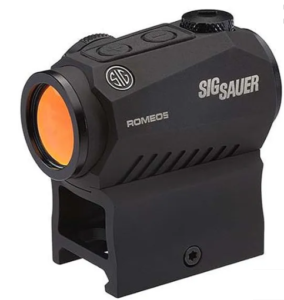
If you’re in the market and looking for the best red dot sights, Vortex and Sig Sauer are among the top recommendations. Both fall in the affordable range, and there isn’t much difference in the prices. However, they significantly differ in optics, turrets, build quality, battery life, illumination, and other unique features.
Here’s a head-to-head comparison that will make you an informed buyer.
Let’s Start With The Basics
Vortex Red Dot has been on the market for too long. Inarguably, it’s a classic among red dot sights. Excellent battery life, ease of usage, and the VIP warranty can give any competitor a run for money.
In comparison, the Sig Sauer Romeo 5 is a relatively new option that has gained popularity over a short time. Thanks to its hero feature, the MOTAC Seriously, it’s top-of-the-line.
Vortex Crossfire 2.0 is a serious offering, albeit for newbie hunters and occasional shooters. As a preferred red dot sight, it does a fine job for 0-100 yards. Designed exclusively for shotguns, AR15s, and PDWs, Vortex scopes are widely recommended for close to mid-range and recreational target shooting.
On the other hand, the Sig Sauer Romeo 5 is built for modern-day MSR/AR platforms. Crisp sight picture, zero distortion, 2 MOA red dots, 8 daylight, and two night visions make it a perfect choice for small caliber rifles with rapid target shooting.
Optics, Size, and Build Quality
As one would expect from budget red dot sights, both Vortex Crossfire and Sig Sauer Romeo 5 have above-average FMC-coated optics. One might see a blue tint due to the dichroic coating that helps in transmission. While Crossfire and Sig Sauer optics have fairly similar offerings, the latter sports a sharper finish and improved color fidelity. If you have ever witnessed more blue tints with the Vortex scope, now you know why.
Vortex Crossfire and Sig Sauer Romeo 5 are among the compact and lightweight closed micro red dot sights. The former weighs 5.2 oz, whereas the latter sits at 5.1 oz. They are almost similar in dimensions.
On the build front, the Sig Sauer Romeo 5 comes with an IPX7 rating. As for Vortex Crossfire, it doesn’t claim anything on paper. However, it can take on just about anything from fog to heavy downpours in a real-time scenario.
Performance
Vortex Crossfire is known for its dot fidelity, with a standard 1 MOA adjustment compared to the Sig Sauer Romeo 5 with 0.5 MOA. However, Romeo 5 has better precision accuracy. Both red dot sights have capped turrets with metal caps for adjustment.
One of the best features of Vortex Crossfire is the exceptional click quality and perfect resistance to avoid overshooting. This is precisely where the Vortex Crossfire has an upper hand over Romeo 5. However, both red dot sights come with recessed elevation turrets, promising extra protection. In a real-time scenario, you may face difficulty capping and uncapping.
If you’re wondering about the illumination, neither the Vortex Crossfire nor the Sig Sauer Romeo 5 are impressive. However, during the night, they will work fine to get you through. There are a total of 11 illumination settings on Vortex Crossfire, whereas Romeo 5 has eight. In both models, two are reserved exclusively for night vision.
Battery Runtime
Undoubtedly, the battery is an intricate factor for a red dot sight. Typically, 50,000 hours is considered the industry’s best for entry-point red dot sights. Here, the classic Vortex Crossfire takes a lead on Sig Sauer Romeo for at least 10,000 hours.
Price
There’s not much to say about the pricing. As entry-level red dot sights, Vortex Crossfire and Sig Sauer Romeo 5 are almost priced similarly, well under $120.
Verdict -Which One Should You Buy
The Vortex Crossfire 2.0 MOA remains a classic entry-level red dot and is certainly the most economical option. Simple design, industry-best battery runtime, and ease of operation make it a great budget RDS that newbie hunters love using. The only downsides are the recessed turrets and the stiff illumination knob. However, they aren’t a deal-breaker.
On the other front, Sig Sauer Romeo 5 uses one of the best MOTAC techs on an entry-level red dot. When looking to invest in a quality topic, it doesn’t get any better than this. That’s why the Romeo 5 isn’t limited to recreational shooting. Civilians can also use it as a great defense tool to protect their homes and property. There’s also a sensor on the Romeo 5 that can detect movement, and an auto-illumination turned on after 120 seconds. On the Vortex Crossfire, it’s the continuous red dot at work without any motion sensor.
Honestly, the jury is still out on the best red dot sight between Vortex Crossfire 2.0 MOA and Sig Sauer Romeo 5. Ultimately, things boil down to one’s preference. And whether you choose a Vortex or a Sig Sauer red dot, you’ll love it.



